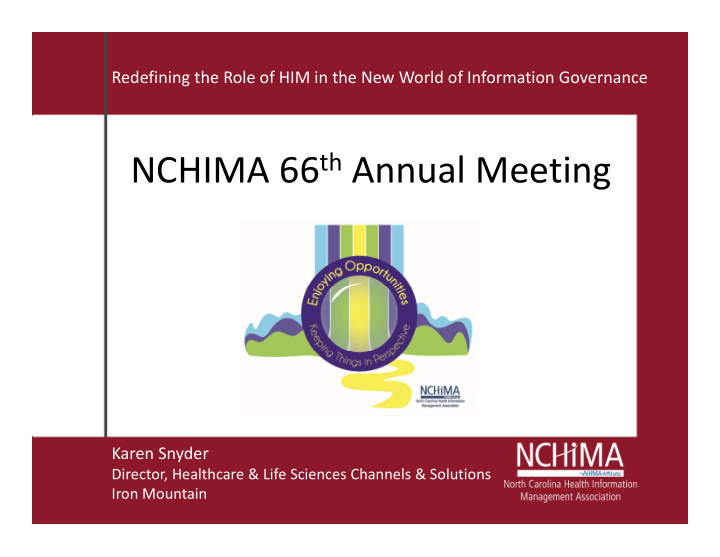



Redefining the Role of HIM in the New World of Information Governance NCHIMA 66 th Annual Meeting Karen Snyder Director, Healthcare & Life Sciences Channels & Solutions Iron Mountain
Themes Covered in Today’s Presentation • Why business as usual is no longer an option for healthcare providers • The challenges and risks associated with legacy HIM models • Elements needed for enterprise-wide information management & governance • A 5-phased roadmap for your transition to Health Information & Records Management (HIRM) 2
Business As Usual is No Longer an Option Compliance Budget Explosive Data Obligations Growth Pressures Healthcare Costs are rising The average cost of a represents a and providers are data breach for significant % of the taking on greater healthcare overall Digital risk with shifting organizations is more Universe, and is payment models . than growing at 48% per $2.1 Million . year. 3
By the Numbers Organizations that have not Organizations that have not 22% initiated a formal IG program initiated a formal IG program Maturity ranking for information Maturity ranking for information 26% deletion & destruction deletion & destruction Organizations realizing significant Organizations realizing significant 84% improvements improvements 4
What It Means 84% 22% 26% Limited Deletion Improvements No IG Program & Destruction Lifecycle Lifecycle Success should be Success should be IG programs less IG programs less tracked via audits tracked via audits prevalent & prevalent & management needs management needs & metrics & metrics mature mature strengthening strengthening 5
6
HIM Challenges Organizational Static Role Policy Gaps Change Gaps in Gaps in Residual legacy Residual legacy Increasing merger & Increasing merger & development & development & HIM model HIM model acquisition activity acquisition activity enforcement enforcement 7
Legacy HIM Models Decentralized, outdated “ silo ” approach increases: Decentralized, outdated “ silo ” approach increases: Risk Duplication Cost 8
Increased Merger & Acquisition Activity Providers are left with a patchwork of inconsistent practices and policies that breed: REDUNDANCY ‐‐‐‐‐‐‐‐ RISK ‐‐‐‐‐‐‐‐ INEFFICIENCY 9
Gaps in Policy Development & Enforcement EHR efficiency and quality gains are highly contingent on the development and enforcement of operational processes and policies that address : Integrity “Without organizational change, technology “Without organizational change, technology Accessibility alone will not produce desired results.” alone will not produce desired results.” Efficacy ‐ Julia Adler‐Milstein, “Health Care Requires Big Changes to ‐ Julia Adler‐Milstein, “Health Care Requires Big Changes to Security Complement New IT,” Harvard Business Review, April 2009 Complement New IT,” Harvard Business Review, April 2009 10
Information Governance Defined An organization-wide framework for managing information throughout its lifecycle and for supporting an organization’s strategy, operations, regulatory, legal, risk, and environmental requirements. 2014 Information Governance in Healthcare Benchmarking Survey by Cohasset Associates and AHIMA and underwritten by Iron Mountain. 11 11
Aligning IG with Organizational Objectives 12
New World HIM Foundational Elements 1. Information is managed as a strategic asset 2. Governance is integral to optimized information use and value 3. Information Management is an enterprise‐wide function 13
Roadmap to Achieve Compliance & Enable Enterprise‐Wide IG I. Create a Governance Structure II. Consistently III. Get Control of lV. Deliver Apply Policy Your Information Insight V. Continuous Improvement: Ongoing Maintenance, Measures & Metrics 14 14
Phase 1: Create a Governance Structure Build the high level business case Establish foundational goals and principles Secure Executive Sponsorship Convene a multidisciplinary steering committee 15
Phase 2: Apply Consistent Policy Create a process for policy development, dissemination and maintenance Continuously update retention guidelines Ensure consistent application and enforcement of policy Centralize change management and version control 16
Phase 3: Get Control of Information Inventory systems of information Identify high-risk, high value data Centralize/consolidate storage offsite Less than 15% Assess your current inventory of organizations have mature Data Maps that Identify duplicate records & identify key data repositories cleanup downstream systems 17
Phase 4: Deliver Insight Provide oversight and visibility of core program metrics Analyze current and historical trends including inventory activity, status, spend Aggregate level views with the ability to filter data 18
Phase 5: Continuous Improvement Identify, capture, & review metrics on an on- going basis Determine an IG assessment cycle Establish a formal process for review and maintenance of the IG program 19
Gaining Buy‐In Align the business case to strategic initiatives Align the business case to strategic initiatives Identify the top‐level business benefits Identify the top‐level business benefits Tie quantifiable business benefits to governance Tie quantifiable business benefits to governance Innovate in areas where you have authority Innovate in areas where you have authority Set performance indicators and measure impact Set performance indicators and measure impact Prioritize projects based on value Prioritize projects based on value 20
21
Recap: Roadmap for Information Governance Make a break from paper Build the case for Enterprise Info Mgmt Organize for Information Governance Measure results Capture organizational learning
Questions? 23
Recommend
More recommend